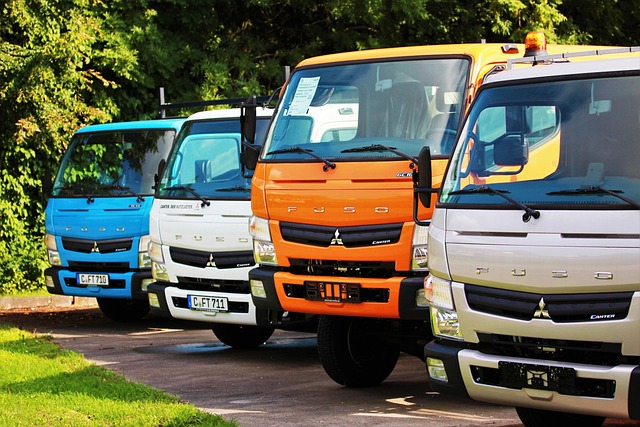Looking to register your car in California? Navigating the process can seem daunting, but with the right guide, it becomes a smooth drive. This article breaks down the California car registration process step-by-step, from gathering essential documents and verifying your vehicle’s VIN (vin verifier) to choosing between online or in-person registration and paying fees. By following these clear instructions, you’ll be cruising towards legal road status in no time.
- Understanding the California Car Registration Process
- Gather Required Documents for Vehicle Registration
- Verify Your Vehicle's VIN (Vehicle Identification Number)
- Choose a Registration Method: Online or In-Person
- Pay the Registration Fees and Receive Your Plate
Understanding the California Car Registration Process

In California, registering a car involves several steps that can seem complex to new vehicle owners. Understanding the process is key to ensuring a smooth experience. The California Department of Motor Vehicles (DMV) is responsible for issuing vehicle registration certificates and conducting vehicle inspections. One crucial component of this process is the verification of the Vehicle Identification Number (VIN), which serves as a unique identifier for your car, much like a fingerprint. This is where tools like the VIN verifier come into play.
A mobile VIN inspection or mobile VIN verification service can simplify the process even further by providing on-site assessments and instant data validation. These services utilize advanced technology to cross-check the VIN against state databases, ensuring its accuracy and helping to avoid potential issues later down the line. By combining traditional DMV procedures with modern verification methods, like using a mobile VIN verifier, California car registration can be efficiently managed.
Gather Required Documents for Vehicle Registration

Before you begin the registration process, it’s crucial to gather all the essential documents for your vehicle. In California, you’ll need a variety of paperwork, including proof of ownership, a valid driver’s license, and a completed Vehicle Registration Application form. Additionally, one of the key requirements is a Vehicle Identification Number (VIN) verification, which can be efficiently handled by using a mobile VIN verifier service.
These services offer a convenient mobile VIN inspection option, allowing you to get your vehicle’s history and current status checked remotely. By having this information readily available, you streamline the registration process significantly. Remember to bring along all necessary documents when visiting the California Department of Motor Vehicles (DMV) to ensure a smooth and successful car registration.
Verify Your Vehicle's VIN (Vehicle Identification Number)

Before registering your car in California, it’s crucial to ensure your vehicle is legitimate and has a valid history. One of the first steps in this process is verifying your Vehicle Identification Number (VIN). This unique 17-character code acts as a fingerprint for your car, providing detailed information about its make, model, year, and even production quality.
Utilize a reliable VIN verifier to check the vehicle’s authenticity and history. Many online services offer mobile vin inspection tools that can cross-reference your VIN against national databases, helping you identify any potential issues or discrepancies. This step ensures that you’re registering a safe and legal vehicle, which is essential for roadworthiness and insurance purposes in California.
Choose a Registration Method: Online or In-Person

When registering your car in California, you have two primary options for submitting your application: online or in-person. Both methods are acceptable and designed to cater to different preferences and circumstances. If you’re comfortable with technology and prefer a hassle-free process, opting for an online registration is a smart choice. This digital approach allows you to complete the entire process from the comfort of your home using the California Department of Motor Vehicles’ (DMV) official website.
Alternatively, if you’d like a more traditional experience or require assistance with any part of the process, visiting a DMV field office in person is an excellent alternative. This method offers the benefit of immediate feedback and support from staff members who can guide you through each step, especially when it comes to verifying your vehicle’s unique identifier, known as the Vehicle Identification Number (VIN). Even if you plan to go digital, considering a mobile VIN inspection or verification service can be advantageous, ensuring all details are accurate before submitting your application.
Pay the Registration Fees and Receive Your Plate

After submitting your application, it’s time to pay the registration fees. The cost will vary depending on the type of vehicle and other factors. You can typically pay online or in person at a California Department of Motor Vehicles (DMV) office. Once your payment is processed, you’ll receive your license plate. This plate bears your unique Vehicle Identification Number (VIN), which serves as both an identifier for your car and a security measure.
Remember, accurate VIN verification is crucial. You might consider using a mobile vin inspection service to ensure the number matches your vehicle perfectly before proceeding with registration. This step safeguards against any potential issues later on and helps in maintaining a smooth registration process.
Registering a car in California is a straightforward process that requires gathering essential documents, verifying your vehicle’s VIN using a reliable vin verifier, and choosing between online or in-person registration. By adhering to these steps and ensuring all fees are paid, you’ll be on the road with a valid car registration in no time. Remember, proper documentation and a clear VIN are crucial for a smooth process, so take the necessary steps to make it happen.
